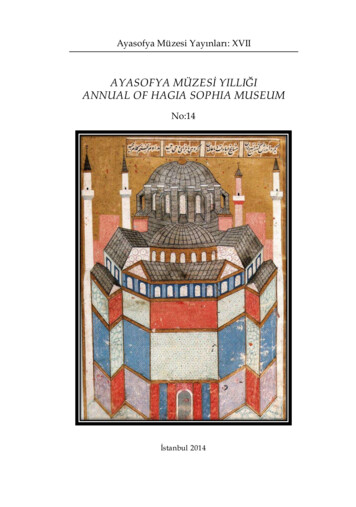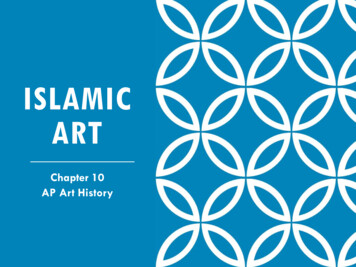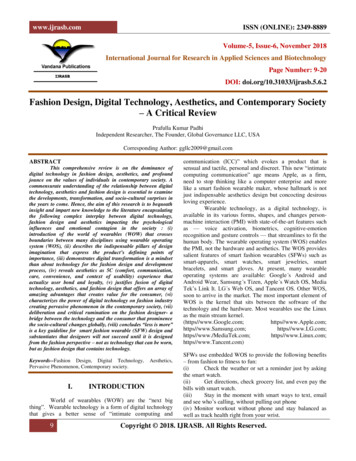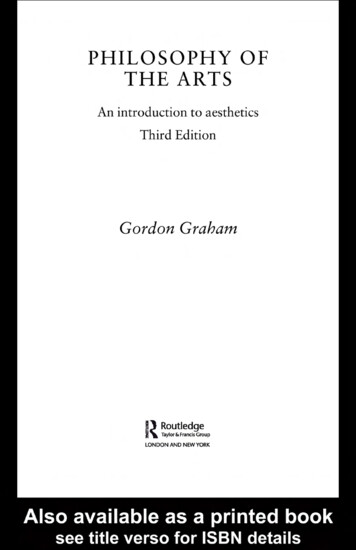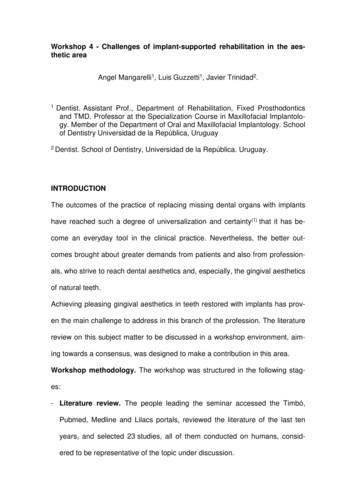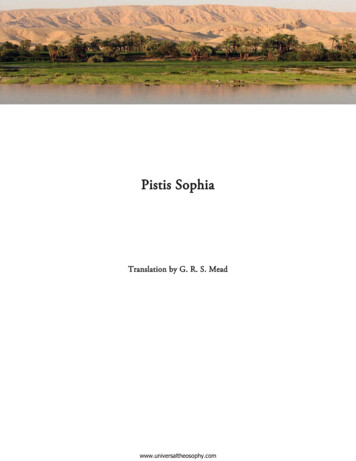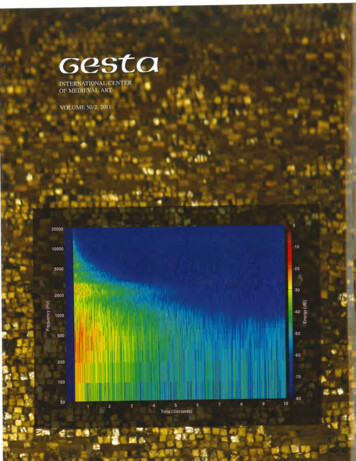
Transcription
Frequency (Hz)Time (Seconds)» 4.VW
Hagia Sophia and Multisensory Aesthetics*BISSERA V. PENTCHEVAStanford UniversityAbstractFocusing on the sixth-century interior of the church ofHagia Sophia in Constantinople, this article explores the waymarble and gold appear and their psychological effect on thespectator as recorded in Byzantine ekphrasis and liturgicaltexts. In turn, this optical shimmer, in Greek, marmarygma,is linked to the acoustic properties of marble, especially itscapacity to reflect sound waves. The meaning of the opticaland acoustic reflection is related to the Eucharistic rite and,more speciflcally, to the concept of animation, empsychosis.The exploration of acoustics is further deepened by the use ofthe sound of exploding balloons and modern digital technologyto measure the reverberation time of the interior and to gener ate with its aid computer auralizations of Byzantine chant, re corded anechoically (with minimal room acoustics). Combiningliterary analysis, philological inquiry, and scientific research,this study uncovers the multisensory aesthetics of Hagia Sophiaand recuperates the notion of aural architecture.Certain materials and artistic choices went into the makingof the sixth-century church of Hagia Sophia in Constantinopleto produce a particular aesthetic appearance (Fig. 1). Althoughno Byzantine texts recorded these aesthetic intentions, thislacuna in the evidence does not mean that no aesthetic pro gram underlay the conceptualization of Hagia Sophia. Rather,an examination of medieval ekphrasis discloses the intent ofthis artistic production: how the interior looked physically andhow it was perceived subjectively. In this paper, I shall drawon ekphrastic texts to extract the aesthetic terms of the artisticconceptualization of the building by specific Byzantine authorsand then- audiences and to retrieve the sensual and religiouseffects of its interior on the contemporary beholder.Recent studies have begun to reveal the performativenature of Byzantine art and how its meaning is created whenlight and shadow trigger the polymorphy of its surfaces, andwhen the beholder perceives these exterior changes as anima tion (empsychosis), projecting his or her own sensual expe rience (pathema) on the object. Aesthetic phenomenology,with its focus on the way an object appears and the effect thisproduces on the spectator, offers a new direction of analysis. Moving away from treating the image as static and monolithic,this alternative approach uncovers and explores the polymor phic and its impact on the human imagination. A contemporaryartwork will serve as an example of the issues engaged byGESTA 50/2 The International Center of Medieval Art 2011aesthetic phenomenology. James Turrell’s piece of sculpture/architecture Space That Sees (1992) is a room without a ceil ing, in which the sky appears like a framed painting. Whenclouds pass by or bh*ds fly overhead, they animate the interiorand make it perform a “representation” of the sky in front ofthe viewer that is phenomenal, not pictorial. The object-spacethus functions as an imagistic engine, using variable naturalphenomena to produce images, while simultaneously stimu lating the viewer’s imagination. In effect, Hagia Sophia offersa similar performative paradigm: the shimmering surfaces ofmarble and gold become animate in the shifting natural light,and these transient manifestations trigger the spectator’s mem ory and imagination to conjure up images. Byzantine ekphi*asis both documents and sustains this interaction between thereal, the perceived, and the imagined. Along with the opti cal aspect, the vast interior of Hagia Sophia revetted in mar ble and gold also has an aural dimension in that it producesextremely reverberant acoustics. Rather than keeping the anal ysis of visual characteristics separate from sonic properties,this study will reunite them, thereby recuperating the idea ofaural architecture.In part literary analysis, philological inquiry, and scien tific work, this essay focuses on the psychology of response,especially on the effect polymorphy has on the viewer and howit was culturally and religiously conditioned.More precisely,the goal of this article is to recover the interior art and architec ture of Hagia Sophia as experienced by the visitor in the sixthcentury. Although a few scholars, such as Liz James, NadineSchibille, and Nicoletta Isar have anticipated some aspects ofmy approach, this is the first work to investigate the originalphenomenological operations of the interior of Hagia Sophia asan integrated whole, in which sight and sound work together. It relies on examination of the primary sources that include thewell-known ekphrasis of Hagia Sophia by Paul the Silentiaryto argue that the structure was designed for reverberation. Tosupport and substantiate my intuition that Hagia Sophia wasdesigned to afford the worshiper a multisensory aesthetic expe rience, I tie aesthetics, etymology, and liturgy into a singleinterpretation, which is thoroughly documented in the notes. Since poetry targets the imagination, and the polymorphic sur faces of marble and gold similarly stir the imagistic capacityof the human brain, I purposefully employ poetic language asa way of reconstituting what I think was an interior of shifting93
FIGURE 1. Hagia Sophia, 532-37 and 562, interior ( Erich Lessing / Art Resource, NY).94Figure 1 also appears in color on the back cover of this issue.
appearances produced by the sheen of translucent marble in thelower half of the building and the glitter of gold on the upperhalf, which worked together to produce a particular effect onthe viewer.For the most part, the scholarly analysis of architectureregards buildings as static entities. Yet an interior of marbleand gold creates an environment of shimmer and reflection,and to do it justice, one needs to employ a dynamic medium." In a radical move, I have resorted to film as a way of recordinghow the marble and gold changed at such moments of transitionas sunrise and sunset. The time selected is important becauseHagia Sophia’s interior was meant to be experienced during theEucharistic liturgy, which coincided with the Byzantine thirdhour of the day (approximately between sunrise and mid-morn ing). Yet, because today Hagia Sophia functions as a museum(AyaSofya Miizesi), visitors cannot enter before nine o’clockand are thus prevented from seeing the polymorphy caused bythe rising sun. Again, my video is not a reconstruction of thesixth-century interior but a record of how light affects reflec tive surfaces. It directs the attention of the modem viewer to theephemeral, which lies at the core of Hagia Sophia’s aesthetic.The use of film as a medium recording the process of changingappearances—the subject of aesthetic phenomenology—offersan alternative means for demonstrating the performative char acter of medieval art.In similar deictic terms, I used as a soundtrack for the filmByzantine chant digitally imprinted with the room acousticsof Hagia Sophia. This computer model is built on the basisof acoustic data gathered in situ. However, this auralization(the process of imprinting recorded music with the acousticparameters of a space) should not be taken as a reconstruc tion of the sixth-century liturgy. Using computer technologymakes the humanist suspicious, and rightly so. But let me definethe parameters of my use of technology. I employ it to modelhow a voice unaccompanied by musical instruments sounds inHagia Sophia based on the cuiTent physical conditions of thebuilding. Just as the architectural historian records and studiesthe material remains of a building and then proposes a recon struction, so, too, the acoustician approaches the same materialevidence when offering an acoustic model. This auralization isvaluable because it gives us the possibility of hearing a base line acoustics for Hagia Sophia and overcoming a logisticalimpasse, because, as a secular space, AyaSofya Miizesi doesthe authors put forward the first systematic study correlatingqualitative (subjective) with quantitative (objective) acousticmeasurements. Embracing Howard and Moretti’s methodol ogy, my project similarly merges art historical analysis withresearch in acoustics and audio recording. It employs visual,textual, and musicological evidence, video, the popping of bal loons, the building of acoustic models, auralizations, and therecording of Byzantine chant. In exploring the concept of auralarchitecture, this article will suggest that Hagia Sophia consti tutes an aesthetic totality—optical and acoustic—that reenactsin its architectural fiction the perceptual experience of polymor phy linked in the Byzantine imagination to coruscating water.The aesthetic it maintains has a linguistic basis in the iterativeGreek root marmar-, connecting mannaron (marble), marmarygma (gleam, glitter), and marmairo (to quiver, sparkle). Theonomatopoeic sound of these words and the image of quiveringwater that they elicit in the listener’s imagination will becomeimportant in the subsequent analysis of polymorphy and reverberance and their role in the Eucharistic ritual.The Linkage between Poetry and AestheticsPaul the Silentiary wrote an ekphrasis of Hagia Sophiarecited during the rededication ceremonies held between 24December 562 and 6 January 563 in the imperial and patri archal palaces.His poetry has been dismissed as a “flowerylanguage” filled with “turgid archaisms,” but it is important toremember that his aristocratic audience was capable of under standing his classicizing style, which was based on Homericvocabulary and written in hexameter (verses 136-1029) withtwo prologues in iambic trimeter (verses 1-80 and 81-135). Paul builds his ekphrasis by using highly evocative images tiedto the Eucharistic ritual. Modern scholars have noted the rich ness of visual imagery in Late Antique literature and the promi nent role ekphrasis played in it.' Paul describes the materials and surfaces of Hagia Sophiaas unstable and shifting in appearance. When he focuses, forinstance, on the marble of the banister (solea), he calls thisparticular stone aiolomorphos, meaning “changing shape andappearances.” " He defines its color through a series of meta phors that bring to mind a variety of natural elements andtextures:not allow music to be performed or recorded on-site.This merging of the humanities with exact sciences has. . . and having an aiolomorphon nature it displays a vari ety ipoikilletai) in respect to shining (aigle). . in partsbeen inspired by Deborah Howard and Laura Moretti’s Soundand Space in Renaissance Venice, a pioneering study of auralarchitecture and polyphony in Counter-Reformation Venice.The book presents acoustic measurements of twelve Venetianit is seen ruddy {ereuthos) mingled with pallor (ochro), orthe fair brightness (selas) of human fingernails; in otherplaces the brilliance turns into a soft wooly whitenesschurches gathered in 2006, the in situ recording of St. John’sCollege Choir, Cambridge, in April 2007, and the gather ing of subjective responses of the audience and choristers tothe acoustics of these interiors. Combining musicology witharchitectural history, archival work, and modern technology.(argennon), gently staying or imitating the beauty/sheen{charin) of yellow boxwood {pyxou) or the semblanceof beeswax which men wash in clear mountain streamsand lay out to dry under the sun’s rays; it turns silvershining (argyphon), yet not completely altering its color,still showing traces of gold.95
The poetry strings together metaphors, connecting the chame leonic appearance of the stone to the color of dawn, the pallorof death, fingernails, yellow boxwood, and beeswax. In particu lar, Paul mixes opposites: ereuthos (ruddy) with ochros (sul len, lifeless). Similarly, wax is malleable and polymorphic; itcan be dry, warm, wet, and cold and still remain wax. Washedin the mountain stream, the wax displays the sheen of silver,while retaining specks of gold. The trope of aporia lurks in thisprofusion of metaphors, yet a similar contrast and oppositionare offered by the actual marble in Hagia Sophia. The versesenvelop the spectator-hearer in a whirl of dualities of senseperceptions: hard and soft, solid and liquid, wet and dry. Antith esis and synkresis alternate in this string of paraded images.Another feature of the poetry is the effort to capture evanes cence, a surface that is translucent and reflective at the sametime, shimmering and polychromatic. The language takes onthe very character of the phenomenon it describes: it changesin order to depict a polychromatic stone with shifting appear ances caused by light.of material structure and ritual. " Gregory of Nyssa, in his hom The terms polymorphy, variety, and shimmer (poikillo,aigle) point to major aesthetic principles that actually guidedthe composition of Late Antique literature. Focusing on Latintexts and the tradition of rhetoric as recorded in the progym-ily of St. Theodore the Recruit (which includes an ekphrasisof the martyrium), states: “Therefore, on the basis of what wecan perceive, we believe in invisible things and because ofwhat we experience in the world, we believe in the promise ofnasmata (manuals for the study of rhetoric), Michael Robertsshows that Late Antique poetry exhibits a marked preferencefor variation {varietas in Latin, poikilia in Greek), repetition,chiastic structuring, and jewel effects. Of these, variation isfundamental, leading to the increasing conception of poetry asan imaging text, and this process of visualization concentratesmore specifically on the instability and mutability of color.The pairing of variation with the effects of light leads Robertsto coin the expression “jeweled style.” This definition of Latinpoetry could easily be applied to the Greek ekphrasis of Paul. Infuture things.This patristic statement attests to a formulationof mystical experience linking perceptual apprehension withthe spiritual. For this reason, I take the scholarly position thatekphrasis of a church building does not function only intertextually, activating a literary tradition, but also integrates a directfact, Gianfranco Agosti reaches many of the same conclusionsin his analysis of sixth-century Classicism in Greek poetry.Moreover, the jewel effects frequently tap into perceptualexperiences. As developed by Stoic epistemology, ekphrasisactivates through vivid language (enargeia) mental images(phantasiai), which are imprints on the soul of sense appre hension. * The phantasiai resurrected by the speaker create inthe listener a simulacrum of perception itself, and this pro cess is a perceptual mimesis, as Ruth Webb observes: “it isthe act of seeing that is imitated, not the object itself.” Givenits reliance on perceptual mimesis, can the ekphrasis serve asa reliable record for a historical moment of aesthetics or aes thetic experience, or phenomenology? In the past, ekphrasiswas sometimes used by twentieth-century art historians in anarchaeological/literal way, to mine the text for evidence aboutthe shape of an object or building.Recent scholarship, for itspart, looks at ekphrasis as a literary style recording a move fromthe sensible-material characteristics of the object to the intel ligible-imaginary realm. Christian ekphrasis, a field that hasonly recently attracted scholarly attention, by contrast, targetsthe spiritual operations, which are activated by the symbiosis96FIGURE 2. Hagia Sophia, 532—37 and 562, view of the Proconnesian floorand south aisle ( Bissera V. Pentcheva}.response to the sensual materiality of the space and uncov ers in it a metaphysical dimension.- And since this particularchurch was sheathed in marble and gold, in analyzing Paul’sekphrasis, I will focus on how glitter, which is linguisticallyembedded in the root marmar- (as in marmaron, marmarygma,amarygma, and marmairo), structures the spiritual operationsof Hagia Sophia. Transitive Terms: Marmaron, Marmara,Marmarygma, and MarmairoOf great significance for this study is the way in whichmarmarygma is connected to marmaron (marble), the Sea ofMarmara, and the image of coruscating water {marmairo). Themarble floor of Hagia Sophia is composed of gray Proconnesianmarble, quanied on the island of Proconnesus in the Sea ofMarmara, and is divided by four bands of green stone, whichwere interpreted in the past as the rivers of paradise (Figs. 2 and3). The gray stone is book-matched, meaning the plaques arecut across the veins and arranged in pairs whose pattern createsa continuous wavelike design (Fig. 4). According to ancientgeology (Theophi'astus, De lapidibiis [ca. 315-305 bce], fol lowing Ah Xoilt' Meteorologia, Book 3), marble was thoughtto be composed of earth particles percolated in water and thensolidified into stone by dry exhalations from the depths of theearth.The association between marble and water grew in the
FIGURE 3. Hagia Sophia, 532-37 and 562, reconstruction of the marble floor seenfi'om above ( Lars Grobe, Oliver Hauck, AndreasNoback, Rudolf H. W. Stichel, Helge Svenshon, Technische Universitdt Darmstadt).Late Antique period, and this linkage acquired a greater visualprominence, forming a new aesthetic standard when the dovegray Proconnesian stone replaced the green Carystian marbleformerly dominant in the interiors of Roman bathhouses andother public buildings. The wave pattern and luminosity ofthe Proconnesus stone stimulated viewers to conjure up in theirimaginations the image of the sea. Moreover, the proximityof the quarries to the capital also encouraged this preferencefor Proconnesian marble in Constantinople. ’ While continu ing this line of research on the cultural perception of marble,my emphasis falls on how the Proconnesian slabs generate theexperience of movement and temporality.When describing the floor of Hagia Sophia, Paul seeks outand dwells on changing appearances:The peak of Proconnesus soothingly spreading over theentire pavement / has gladly given its back to the lifegiving ruler [Christ/the emperor], / the radiance of theBosphorus softly rufQing / transmutes from the deepestdarkness of swollen waters (akrokelainiontos) to the softwhiteness {argennoio) of radiant metal (inetalloii)? Paul attributes animacy to the island of Proconnesus, willinglyspreading its back for the emperor and Christ. Its stone, cutinto slabs, forms the floor of the Great Church. Its polishedsurfaces resemble the radiance given off by the softly rufflingBosphorus. Here the poet uses the onomatopoeic phrisousa, aword containing the sound of the wind. An animate, as opposedto static, image emerges in the poetry, based on the memory ofFIGURE 4. Hagia Sophia, 532-37 and 562, sunlight glistening on the Procon nesian marble floor { Bissera V. Pentcheva).coruscating water. Its shimmering surface is in constant flux,continually changing its shape. The next line of the poem inten sifies this spectacle of shifting, chameleonic appearances; theradiance changes from the deepest darkness of gushing, swollenwaters (akrokelainos) into the soft whiteness of warm sheep’swool (argennos), shining with the radiance of metal (metallon).The verse aptly renders the effects of polymorphy, or poikilia? In Paul’s ekphrasis, marble acquires the varying appearance ofwater, transmuting into wool, then into metal. The words evokean alchemical process, in which stone liquefies into water andmolten metal.97
FIGURE 5.FIGURE 6.Hagia Sophia, 532-37 and 562, north aisle, sunlight gilding theProconnesian marble floor ( Bissera V. Pentcheva).Hagia Sophia, 532—37 and 562, north aisle, sunlight glistening onthe marble revetment ( Bissera V. Pentcheva).As he calls up the image of the Bosphorus, Paul encour ages his audience to dwell on movement and change: water ruf fled by winds, light transforming the surface into liquid metal.To an extent, this polymorphy of the Proconnesian marble isstill observable today. At dawn the stone glows with the lusterof mother-of-pearl that recalls the opalescence of the Bospho 'rus at certain times of the day (Figs. 5-7). So far, this kineticaspect of the perceptual images evoked in Late Antique poetryhas not been discussed in the scholarship. Poikilia, fragmen tation, miniaturization, and the jeweled style have been high lighted instead. " I would like to add to them the concept ofmarmar-, which issues from the image of running or quiver ing water and conveys the liquescent, fugitive, and ephemeralin Hagia Sophia. Paul recognizes the polymorphic nature ofmarble not only in its polychi'omacity but also in the way itssurfaces interact with light. He is attracted to this change andsees a link between it and the image of quivering water. Theseverses following his description of the Proconnesian floor willprove the point:— FIGURE 7.,.--1- A view of the Bosphorus in the morning on 6 December 2010( Bissera V. Pentcheva).by the word marmairo (to sparkle, quiver), as the verb againconjures up the image of scintillating water. The shimmer ofThe ceiling encompassing gold-inlaid tesserae, / whosegold is seen through the metaphor of water. Marmairo forms anear-phonetic pair with marmaron, marmaryge, and marmarygma (sparkle), thereby linking these materials and phenomenaaurally into one transmuting visual entity.pouring down (chyden) in glittering (marmairousa) gold streaming {chrysorry to s) ray {aktis) / uTesistibly bouncesoff the faces of the faithful. The lines bespeak the metamorphosis of solid metal into a riverof shimmering gold gliding across reflective mai'ble (Figs. 5,6, and 8). The flow (chyde) of the fluid gold (chrysorrytos)ray (aktis) liquefies the ceiling as its shimmer bounces off thefaces of the faithful (Figs. 9 and 10). Natural light has ananimating effect on the interior. At dawn, I have found, thefirst rays cause the marble revetments to acquire relief (Fig. 6).Similarly, when sunlight falls on the tessellated Proconnesianframes, it transforms them into gilded streams, thus unifyingthe gold mosaic with the marble (Figs. 5, 6, 8, and 9). Thisperceptual merging of gold and marble is linguistically enabled98The Linkage o/Marmarygma and Charis.’Animation as EmpsychosisThe iterative marmar- presents the perceived transforma tion of different materials—light, metal, and stone—into water,and it is this image of water that offers a kinetic dimensionto Paul’s imagined world. Similarly, in conveying movement,the iterative marmar- foregrounds the process that causes inertthings to become alive (empsychos). We can detect how theconcept of liveliness operates by analyzing Paul’s most memo rable evocation of surging water in his ekphrasis of the amboFigures 6 and 7 also appear in the color plates between pp. 162 and 163 of this issue.
FIGURE 8. Hagia Sophia, 532-37 and 562, sunlight framing in gold the tessellated marble frames of the revetment f Bissera V. Pentcheva).FIGURE 9. Hagia Sophia, 532-37 and 562, sunlight in a tympanum in thesouth aisle makes the gold mosaic shimmer f Bissera V. Pentcheva).Animate and inanimate transform into each other. Anthropolo gists have observed how combining the memory of sensualperception with that of ritual stimulates the most vivid imag inings. This is exactly the combination put forward by Paul.The religious zeal and physical energy expended in trying totouch the Gospel book become subsumed in his poetry by theimage of breaking waves. His ekphrasis seeks to express dyna mism and the life that bursts forth and imbues the inert withmovement: the kymata (waves) of kinymenon demon (movingpeople). Just like marmaron, marmarygma, and marmairo, thenear-phonetic pair of kyma and kinymai strengthens the powerof the metaphor and intensifies the intertwining of animate andinanimate. This phenomenon resembles Alfred GelTs conceptof interdigitation, when the subject projects his animacy on theFIGURE 10. Hagia Sophia, 532-37 and 562, Justinianic gold glass mosaic inthe vaulting of the inner narthex ( Bissera V. Pentcheva).and solea. The power of this scene stems from the merging ofperceptual memories with a recollection of the liturgical rite:And as an island rises amid the waves of the sea . . . ,so in the midst of the boundless temple rises uprightthe tower-like ambo of stone. . . . Here the priest whobrings the good tidings passes along on his return fromthe ambo, holding aloft the golden book; and while thecrowd strives in honor of the immaculate God to touchthe sacred book with their lips and hands, the countlesswaves of the surging people break around. Paul the Silentiary describes the ambo through the metaphorof an island washed by the sea. He expands on this figure ofspeech by comparing the congregation’s pushing forward toobject and thus experiences the latter as alive.The image of the breaking waves conveys the processof inspiriting matter, which in turn evokes the Eucharist, amodel that his audience understood well. For the Eucharist, inessence, enacts the imparting of spirit into matter, transform ing bread and wine into flesh and blood.' Pneuma (the HolySpirit) causes this transformation when it descends in the scentof burning incense over the gifts. In employing terms such asmarmairo and marmarygma and kyma and kinymai, Paul com pels his spectators-hearers to recognize in the changing appear ances of marble and gold the presence of vivifying force—theHoly Spirit.The movement of the waves and the quiver of glitteringgold mosaic reflected from the marble floor create an image ofa world in flux. To this dynamic of molten metal and sparklingwater, Paul adds the image of woods and lush meadows inspring that the marble columns of the naos and the revetmentsrepresent, and he seeks in them the manifestation of empsychosis linking glitter with charis (Fig. 11):reach the Gospel book to that of surging waves. The metaphoriclanguage shifts between the man-made interior and nature out In turn four columns firmly resting on the ground lift [theside: floor becomes sea; the pulpit, island; the people, waves.six columns of the gallery] by unshaken force, / withFigure 10 also appear in the color plates between pp. 162 and 163, and parts of Figure 9 form the background for the cover.99
gilded capitals they stand effusing grace (charitessi) / inthe shimmer (amarygmata) of Thessalian marble. / Theyseparate the airy central performance stage (kallichoroio)of the temple under the dome / along the length of theneighboring aisles. / Never in the land of the Molossiansdid they cut such columns, high-crested, full of grace(charientas), blooming (tethelotas) in the color harmonyof variegated (daidaleoisi) forests and flowers.The four Thessalian marble columns appear as trees firmlyrooted in the ground. Their gilded capitals please the eye withbeauty {charitessi) and shimmer {amarygma). While charissuggests beauty and grace, it also evokes the memory of theEucharist with its concomitant descent of pneuma.' The glitterof the gilded acanthus in the spandrels stimulates the viewer tosee them as animate, and, similarly, the shafts of the colunmsare filled with energy, perceived in the gleam {amarygma).Speckled with green, gray, and white, the Thessalian colunmssuggest the perceptual mimesis of polychromatic forests andflowers {alsesi kai anthesi). In Greek, “flower” also designates“color.” Consequently, the image of a meadow of flowers isjuxtaposed to the dynamic contrast of the shadowy forest; thisantithesis has a kinetic dimension.Daidalos, meaning “com plex” or “variegated,” expresses this dynamic multitonalityand luster. The colored marble of the columns does not offeran abstract depiction of landscape. Instead, the juxtapositionof shimmer and luminosity stirs the perceptual memory ofbrightness and shadow: the amarygma (sheen) of marmaroninfused with the charis (grace, beauty) of gold. Roberts, whoanalyzed this principle of contrast and juxtaposition in LateFIGURE 11. Hagia Sophia, 532-37 and 562, naos and south aisle ( Vanni /Art Resource, NY).Antique poetry, also characterizes this literature as a meadowin spring." His definition is fully justified when we look at Paulthe Silentiary’s ekphrasis of the marble revetments. His poetryuses marble to construct an image of a landscape filled withcontrasting colors.Paul’s poetry is not alone in intensifying the imagery; thematerial production itself becomes more lavish in this period.Marble revetments originated in Hellenistic architecture andbecame prominent in Late Roman Republican buildings, andthe trend continued during the Imperial age. With Constantine,marble revetments entered the vocabulary of church architec ture." What makes Hagia Sophia exceptional is the quantityand rich variety of marble used for its interior. Paul engagesthe perceptual properties of these revetments:And all the precious [stone] that sprung from Onyx /gleaming with the radiance of gold tesserae {metallo) /and that which the land of Atrax produces / in the smoothplains, not the highlands, / in part with the intense greenof spring {chloaonta) not unlike emerald, / in part fromthe deep green {bathymenou chloerou) appearing almostblue in form {kyanopidi morphei)\ / just like the juxta position of snow next to the shimmer {marmaryges) ofblack: / an intertwined charis has risen from the stone.100The way onyx looks is compared to the radiance of gold tes serae {metallon), while the face of the stone from Atrax alter nates between the sheen of spring green and a deep greenalmost resembling dark blue. These lines capture the cultur ally specific color perception of Byzantium. Rather than hue,color words stress brightness and saturation." Once again, anintense contrast is sought between the light-reflective and thelight-absorptive properties of materials.The metamorphosisis phenomenal, triggered by ambient changes. The shifts andcontrasts express a larger concept, that of the presence of spiiitin matter: “an intertwined charis has risen from the stone.”Glitter
well-known ekphrasis of Hagia Sophia by Paul the Silentiary to argue that the structure was designed for reverberation. To support and substantiate my intuition that Hagia Sophia was designed to afford the worshiper a multisensory aesthetic expe rience, I tie aesthetics, etymology, and liturgy into a single
